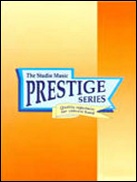Results
-
 £72.00
£72.00At Sunrise
Inspired by a sunrise over the water in the composer's home state of Florida, "At Sunrise" includes a beautiful and memorable melody moving amid changing textures and harmonies, leading to a magnificent full ensemble. It begins gently, with a transparent quality to portray the first signs of light. Breathtaking colors then unfold with the rich, lyric sounds presented here with uncommon sensitivity, leading to a dramatic final climax. From here, the work subsides, ending as it began, leaving a spell not soon forgotten. Ideal for concert and festival use, this is lyric music of the highest quality!
Estimated dispatch 7-14 working days
-
£89.99
Auld Lang Syne Wind Band Set (Score & Parts)
Whereas 'Auld Lang Syne' may be considered the best-known Scottish song ever, yet at the same time it is an obscure one, for there are but few people who know the complete text by heart. After the familiar 'Should auld acquaintance be forgot .....' many people take their refuge to lyrics like 'rum tee dum ta dee ..... lah, lah, lah ........... for auld lang syne'. Even in Scotland only a handful of persons know the entire text and are able to give a correct rendering of it. The current lyrics have been attributed to the Scottish poet Robert Burns. Burns, however, he did not write the whole poem : after he had heard an old man sing the centuries-old Scotch ballad, he wrote it down and added a number of stanzas (1788). Historical research teaches us that the ballad served many purposes, both political and religious. Nowadays, 'Auld Lang Syne' is sung as a Christmas Carol and it is also sung on New Year's Eve at the turning of the year. Apart from that, though, the song is also sung on many other occasions - sometimes with different lyrics, which usually have Love, Friendship and/or Parting as their themes, as these go well with the fascinating melody. In this arrangement a low-sounding solo instrument is central. The harmonization in the accompaniment fits in perfectly with the sentiments this song will evoke. Should auld acquaintance be forgot And never brought to mind? Should auld acquintance be forgot. And days of auld lang syne? For auld lang syne, my dear, For auld lang syne, We'll take a cup of kindness yet, For auld lang syne. 03:00
Estimated dispatch 7-14 working days
-
 £39.60
£39.60Band-o-rama (Concert Band - Score and Parts)
If you are looking for a piece that can be used to combine your Elementary, Middle School and High School bands for a mass performance - here it is! Band-o-rama march contains parts for elementary, middle school/intermediate, and high school/advancing players. The parts marked A are for the high school level, B parts for middle school and C parts for elementary. If a part does not have an indication of A, B or C, it is intended to be the part for all levels. The unique part of this wonderful march is that each set works independently and can be performed with or without the other.
Estimated dispatch 7-14 working days
-
£84.99
Bread and Games Wind Band Set (Score & Parts)
Panem et Circenses', Bread and Games were essential for keeping the citizens of ancient Rome in check. While the bread was meant for the poorest among the Romans, the Games were Popular Pastime Number One for everybody.There were different kinds of games, such as chariot races (especially popular with female spectators), or wild-beast fights, where lions, tigers, bulls or bears were set on one another or even on human beings. Most popular, however, were the Gladiator fights. In 'Bread and Games' William Vean depicts one of the many fights in the antique Colosseum. 1. Entrance of the Gladiators: By powerful bugle-calls the attention of the people was asked for, after which the Gladiators entered the Arena at the sound of heroic marching-music.2.Swordfight: We can hear that the fights were not mere child's play in this part.On the contrary, they were a matter of life and death and were fought accordingly.3.Mercy of the Emperor: Sometimes a wounded gladiator could be fortunate, depending on the mercy of the audience. Waving one's handkerchief meant mercy, a turned-down thumb meant no pardon. The Emperor had the right to take the final decision, but he usually complied with the wish of the majority of the public. 4.Lap of Honour: Gladiators were mainly selected among slaves, convicted criminals, or prisoners of war. Consequently, winning was very important, as it would mean fame, honour and sometimes even wealth. A lap of honour, therefore, was the winner's due reward. 06:00
Estimated dispatch 7-14 working days
-
 £149.99
£149.99Bridge Between Nations Wind Band Set (Score & Parts)
This work builds a musical bridge between the nations of the European Union. In this composition each country is represented by a fragment of its national anthem. The listener will continually be surprised by the creative way the national anthems are presented. The national anthems of the nations that have become part of the EU in 2004 have already been included in this piece. Because the fragments follow each other and complement each other in a logical way, this work does not sound like a regular medley but rather like a varied concert work with interesting elements of folklore. For most of the national anthems Jacob de Haan has chosen a minor key, which gives this work an extra emotional, sometimes melancholic overtone. 0:09:30
Estimated dispatch 7-14 working days
-
 £104.99
£104.99Celtic Gathering Wind Band Set (Score & Parts)
Roland Kernen has developed a true fascination for the traditional music scene and for Celtic folk music in particular. The Celts fed on a rich blend of legend and myth which is skillfully portrayed in Celtic Gathering. This lyrical piece embraces two musical atmospheres. The first melodic line, written in a minor key, expresses the cheerful character of a group dance, whilst the second line, written in a major key, portrays perfectly the joyful mood of a Celt village.Why not add a touch of Celtic magic to your band repertoire.
Estimated dispatch 7-14 working days
-
 £209.95
£209.95Clarinet Concerto (Ellerby) (Prestige Concert Band - Score and Parts) - Ellerby, Martin
The opening 'Carousel' takes a leaf out of the American minimalist composers' book and is energetic and resourceful throughout, conjuring up images of a fairground ride that is not too much of an intrepid adventure! The central 'Cameo' presents and re-presents a delicate, highly legato, melisma for the soloist. A somewhat brooding central episode provides both a moment of contrast and the opportunity for the soloist to deliver some free cadenza-type material before returning to the security of the opening calm. The closing 'Charabanc' is a freely developed rondo-style finale embracing influences from jazz and other light music forms. Listeners are encouraged to use their own imagination, as it is intended to be whatever you want it to be!Performance time 15'15"This work was commissioned by and is dedicated to Linda Merrick and is featured on the recording QPRM137D LINDA MERRICK, Linda Merrick and the RNCM Wind Orchestra
Estimated dispatch 7-14 working days
-
 £44.95
£44.95Clarinet Concerto (Ellerby) (Prestige Concert Band - Score only) - Ellerby, Martin
The opening 'Carousel' takes a leaf out of the American minimalist composers' book and is energetic and resourceful throughout, conjuring up images of a fairground ride that is not too much of an intrepid adventure! The central 'Cameo' presents and re-presents a delicate, highly legato, melisma for the soloist. A somewhat brooding central episode provides both a moment of contrast and the opportunity for the soloist to deliver some free cadenza-type material before returning to the security of the opening calm. The closing 'Charabanc' is a freely developed rondo-style finale embracing influences from jazz and other light music forms. Listeners are encouraged to use their own imagination, as it is intended to be whatever you want it to be!Performance time 15'15"This work was commissioned by and is dedicated to Linda Merrick and is featured on the recording QPRM137D LINDA MERRICK, Linda Merrick and the RNCM Wind Orchestra
Estimated dispatch 7-14 working days
-
£84.99
Creamy and Crispy Wind Band Set (Score & Parts)
This composition of Marc Cunningham has four parts, and takes place on a sunny day in a picturesque town. 1. Promenade Many people walk through the city. The band passes through the streets. People are strolling along the avenues and amorous couples are sitting on a park bench. 2. Lovey Dovey One of these couples is knee-deep in love. 3. Crispy and Creamy Here the contrasts between a crisp staccato section in two-four time signature and a smooth legato section in three-four time signature are depicted. Is Crispy the boy and Creamy the girl? 4. Farewell In the last particle the couple says goodbye. We still think back to the walk through the city. It sounds a little less happy now. Not everyone is good at saying goodbye, sometimes a tear flows. 07:45
Estimated dispatch 7-14 working days
-
 £67.32
£67.32Cruzan Dances
A distinctive and delightful concert piece that is unique in many ways. Features a large number of percussion parts which make it perfect for the band with a plethora of drummers and it also contains a very effective optional piano solo which not too difficult.
Estimated dispatch 7-14 working days
